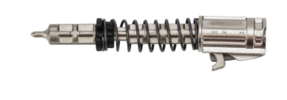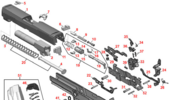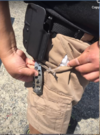Damn_Yankee
"Now go away, or I shall taunt you a second time"
2A Bourbon Hound 2024
Supporting Member
Sure, ’cause nobody was injured and no large contract was in jeopardy.Wow, sig actually admitted there was a defective part in there. That's new.
That was my first response before watching the video, and ordinarily, I'd be in agreement.My $$ is that he reholstered with his finger on the trigger.
That was my first response before watching the video, and ordinarily, I'd be in agreement.
But, two things stand out that make me think...maybe not.
First, he doesn't strike me as someone unfamiliar with pistols of that class and the inherent dangers of hasty reholstering with anything in the path of the trigger.
Second, he said that he'd familiarized himself with the pistol with 800 rounds prior to taking it to the match. Surely during that process, he'd reholstered the gun several times.
Maybe he'll follow up with statements from his witnesses.
Understood and agreed, but he didn't say that his 800 rounds was meaningful training, only that he'd fired 800 rounds through the gun prior to the match...AND...you're assuming that he'd never had experience with a pistol of that class.no amount of training eliminates human error. Not 800, 8000 or 80,000 rounds. The fact that he thinks 800 rounds is a meaningful amount of training is hilarious.
While human error is the cause of the vast majority of negligent firearm discharges three important things he said in the video back up his account:Understood and agreed, but he didn't say that his 800 rounds was meaningful training, only that he'd fired 800 rounds through the gun prior to the match...AND...you're assuming that he'd never had experience with a pistol of that class.
Could it have been the holster itself rather than his finger on the trigger?
Like you, I'd like to have more information, mainly to satisfy my own curiosity.
"Law of parsimony (aka Occam’s razor) dictates that he had his finger on the trigger during reholstering. This is a common error, and common things are common."
Oh, absolutely. Reholstering is the reason that the US Army wanted a manual safety on the 1911. Even in those antiquited days, the thinking heads understood that a man under stress may forget to take his finger off the trigger before jamming a cocked pistol into a holster.



While human error is the cause of the vast majority of negligent firearm discharges three important things he said in the video back up his account:
1. It was during a match with an RO right there. Not only would the shooter have to make a mistake but so would the RO. Still possible but far less likely.
2. The pistol was in the holster after the errant shot. If it was the classic “finger on the trigger when you holster” the pistol would have still been in his hand.
3. Most importantly Sig found and admitted to a mechanical defect. When it comes to problems that can be litigated companies don’t easily admit to fault.
So, I'm thinking the guy's description of the part is maybe off a little. The "return spring" would be the "reset spring" I think. I can't see how a faulure there could cause a gun to fire, when that spring releases energy it moves the stirker away from the primer. That assembly does include a "striker safety lock spring". I don't know what that is, but it sounds like it could fail and defeat something to cause a bad result.
Yep. I still think the sear mating surface tolerances are too little, and the variance between the parts tolerances in the assembly are the culprit. Some guns will never do this. Others with the right mix of too small parts might bo bang. Now we add the third wrinkle...it's possible that the safety lock...the 2nd line of defense might be doing the heavy lifting on these smaller tolerance guns and with enough use the safety lock/safety lock spring fails.If the safety lock or its spring failed, the sear would still have to drop to release the striker, so that's either a 2nd mechanical failure or the user pulled the trigger.
In a cocked/ready position, I don't see how the striker reset spring has any mechanical effect whatsoever.
It would be nice to get a true post-mortem of what happened here, beyond "everyone agrees my gun totally went off by itself, bro" but I doubt we ever will.


Oh, absolutely. Reholstering is the reason that the US Army wanted a manual safety on the 1911. Even in those antiquited days, the thinking heads understood that a man under stress may forget to take his finger off the trigger before jamming a cocked pistol into a holster.
View attachment 536815View attachment 536816
There are definite differences in the amount of shirt material near the entrance to the holster in the two pics. The first one is about the 1:25 mark, the second at about 1:45. He obviously tucked his shirt in for the second pic [Edit: or has his right shoulder raised.]
Reholster for the 4th time on a stage with live rounds, material gets into the trigger guard, arms lifted to surrender position and bang gun goes off. To me that's not out of the realm of probabilities.
Since Sig said the gun had a problem I guess my analysis and speculation are off-base, or at least moot. I have extra girth, and therefore shirt material, around my middle. I had SOs at IDPA say "watch your shirt" enough that I almost instinctively use my left hand to pull my shirt tight.
As I said in another thread, I keep a P320 Tacops with an added X-grip under the pillow next to me, along with a Ruger American Pistol. I instructed the Ruger to shoot the Sig if it made a move during the night. So far, so good.
Does anyone know how much of the P320's fire control system design bleeds over to the P365?
Edit: As I think about it more, the split theoretically could be caused by the brass attempting to eject, but I just racked the slide on a fully loaded pistol still in the holster, and it only failed to eject the round and it was loose in the chamber, not wedged against the holster, etc.
There are no guarantees. There are only means to stack the deck in our favor.Would be just as easy to forget the safety under stress before jamming pistol in holster..
Excellent question. I have been eyeballing P365’s and this potential issue gives me something to consider.Does anyone know how much of the P320's fire control system design bleeds over to the P365?
Personally while I love the feel of the 365, I won't own a Sig until they stop releasing their guns to the public to QAExcellent question. I have been eyeballing P365’s and this potential issue gives me something to consider.
There are no guarantees. There are only means to stack the deck in our favor.
It's easier to teach someone to do something than it is to stop them from something they're already doing in a stressful situation. Evidence is found in cars that overturn at high speeds are often found with the engines blown when the drivers couldn't get off the loud pedal...but getting off the gas to apply the brake when trying to avoid a collision is done without thinking.
When a car traveling at high speed loses contact with the road and goes airborne, the driver's foot is planted on the floor. The engine then revs to the point that it comes unwrapped because the driver is only thinking that he's about to die. Lifting his foot isn't part of that. Being a spectator at a NASCAR event where a car goes airborne will bear this out.Indeed I agree.
You lost me here. Not sure what you mean.
When a car traveling at high speed loses contact with the road and goes airborne, the driver's foot is planted on the floor. The engine then revs to the point that it comes unwrapped because the driver is only thinking that he's about to die. Lifting his foot isn't part of that. Being a spectator at a NASCAR event where a car goes airborne will bear this out.
Colt submitted eight pistols to the army in April 1910 for evaluation. They were returned with a request for a slide locking manual safety from the US Cavalry, because they understood that a mounted trooper in the middle of a pitched battle could likely find a cocked pistol in one hand, and the reins connected to a terrified horse in the other...needing both hands to regain control of the horse. They wanted a means to quickly make the pistol safe for reholstering and a means to prevent the slide from being pushed out of battery, possibly not returning when the gun was redrawn.
Prior to that, the half cock was the only manual safety on the gun.
They also understood that a man could be taught by repetition to perform a specific action not related to what he was doing easier than teaching him to stop doing what he was already doing when the situation went suddenly sideways. In a panic, forgetting to "lift his foot" would be more likely than forgetting to lift his thumb to engage the safety.
Safety features on a firearm aren't put there for what will happen as much as they are for what COULD happen. The 1911's grip safety, for instance, is a drop safety...installed not because the gun would fire if dropped muzzle up...but because it COULD.
The thumb safety wasn't put there because the cavalryman WOULD forget to take his finger off the trigger, but because he MIGHT. Obviously, doing both is ideal, but sometimes the ideal flies out the window when we're not on a square range with lead flying in one direction.
Safeties aren't there to let us get stupid. They're there to eliminate the human factor as much as possible.
Every time we holster a cocked, loaded pistol, it sweeps some part of our body unless we're using a competition holster that keeps the muzzle well away from us, and even that isn't a guarantee. Those holsters not only speed up the draw, they position the muzzle, too.
And again, there are no guarantees. The 1911's manual safety was put there for the reasons I outlined. We all know that the most likely time...by large margin...to have an ND is while drawing or holstering.Right. But under stress someone can just as easily forget to activate safety and jam it in holster
And again, there are no guarantees. The 1911's manual safety was put there for the reasons I outlined. We all know that the most likely time...by large margin...to have an ND is while drawing or holstering.
The points are technical...not tactical. No manual safety works if we don't make an effort to use it, but a gun designed WITHOUT a manual safety doesn't give us the opportunity or the choice.
This is why I like hammer guns and manual safeties. I even place my thumb against the hammer spur of double action revolvers when I holster them.
Before we can make a call either way, we need to know a few things about this pistol's fire controls.
Mainly, is there a redundant or "fail safe" mechanism in place to arrest the striker should the striker release mechanism break or fail? Think half cock notch or something of similar function.
In that case, he pulled the trigger...whether he knew it or not...and the firing pin return spring explanation is sheep dip.There are three P320 safeties relevant to this question:
- A striker safety lever blocks the striker from moving forward unless it's pushed out of place by the movement of the trigger bar (analogous to the Glock striker block plunger)
- A disconnect safety disengages the trigger unless the slide is in battery
- The sear has a backup notch which catches the striker if it slips off the primary notch

